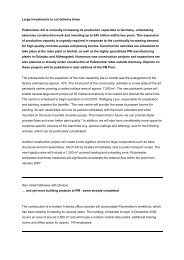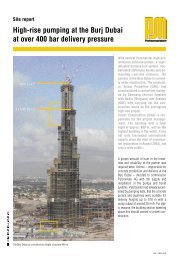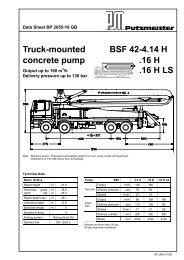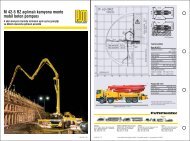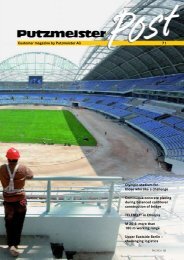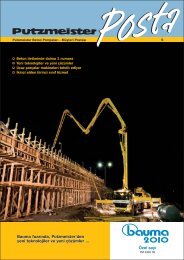2005 - Putzmeister
2005 - Putzmeister
2005 - Putzmeister
- No tags were found...
Create successful ePaper yourself
Turn your PDF publications into a flip-book with our unique Google optimized e-Paper software.
The Magazine for our Customers and Friends 62PM 3652 GB
Title StoryHigh standards of quality16Dubai’s construction industry is runningflat-out. It features a company that hasbeen making significant changes to thecity’s skyline for years: UNIVERSALCONCRETE PRODUCTS LTD. CO(UNIMIX) LLC. The company has provedrepeatedly that it belongs among Dubai’sleading ready-mixed concrete manufacturers.Meanwhile, UNIMIX has even wonthe contract to supply and place the concretefor the prestigious Burj Dubai,which, at over 700 m high, is the tallestbuilding in the world. UNIMIX orderedthe concrete pumps and distributionbooms required for this project from<strong>Putzmeister</strong>. .The list of impressive high-rise buildings,for which UNIMIX has supplied theconcrete and provided the pump serviceover the past years, is long and the namesof the buildings have meanwhile becomewell-known terms. Take, for example, the7-star Burj Al Arab hotel, the 309 and355 metre high hotel and office towers ofEmirates Towers, the 51 floors of theMarina Crown Tower luxury apartmentcomplex and many more.For the construction of these landmarks ofmodern architecture, UNIMIX is not onlyinvolved as the supplier of high-qualityconcrete, but also uses its concrete pumpsand booms on the construction sites. Withan average age of only four years, theUNIMIX fleet is relatively young and themachines are well-maintained. ”Our balancedstrategy has led to controlled growthand considerable sales growth. It is thebalance of high-quality products, customerorientationand company strengths thatUNIMIX has to thank for its position in themarket and its involvement in numeroushigh-rise projects,“ says the UNIMIXmanaging director Khalid MohamadS.Bakhit with pride.Within just 4 years, the company has doubledits capacity. It has invested not only inmodern concrete mixing plants and truckmixers, but also in concrete pumps andbooms. E.R. Menon, Technical Director ofUNIMIX managing director Khalid Mohd S. Al Bakhit(centre), Technical Director E.R. Menon (left) andworkshop manager J.P. SantoshUNIMIX: ”To meet the growing requirementsof the market, we are implementingan active investment policy.“ The companycurrently operates 120 truck mixers,20 truck-mounted concrete pumps, 16 stationaryconcrete pumps and 36 stationarybooms. The UNIMIX mixing plants producedapproximately 1,500,000 m 3 of concretein 2004, around 75 % of this was pumped.Well-trained employees –economic concrete pumpsThe service lives of the typical wear partsplay an important role for pumping thesequantities. This is not only with regard tothe procurement costs of the new parts, butalso because of the machine downtimesduring replacement of worn parts. UNI-MIX workshop leader J.P. Santos givessome figures: ”We replace the S transfertubes on our <strong>Putzmeister</strong> concrete pumpsafter approximately 120,000 m 3 and thespectacle wear plates after pumping anaverage of 80,000 m 3 of concrete. As forthe delivery line, our booms are equippedwith double-layer Proline pipes. They willlast up to 100,000 m 3 !“15UNIMIX proudly decorates its truck mixer drums with pictures of its most spectacular and sophisticated construction sites. This painting of the future Burj Dubai is very new.17The production of high-quality concrete isa science. Skilled concrete technologists atUNIMIX develop various mixture breakdowns:concrete with 100 N/mm 2 compressivestrength, self-compressed concrete withlow heat of hydration and also concretetypes of high strength with equally highelasticity. The quality of the cement supplied,microsilicate, fly ash and other fineparticles is monitored in our own laboratoryjust as is the high standard of the endproduct concrete.Incidentally – the various concrete mixturesmentioned above will also be implementedby UNIMIX and pumped with<strong>Putzmeister</strong> high-performance pumps forthe prestigious Burj Dubai, the tallest towerin the world at well over 700 m. Whenasked about the status of the preparations,E.R. Menon holds back on the details: ”Indetailed tests, <strong>Putzmeister</strong> testing engineershave checked the pumpability of this extremelysuperior concrete and simulated thehigh pressures expected. We will reveal thefinal pumping height at a later date. UNI-MIX has, however, already decided on the7-10 members of the concrete team. Theyare our best, most experienced people!“6PM 3652 GBOne of the UNIMIX BSA 14000 HP-D high-pressure concrete pumps. On the right is a UNIMIX truck mixer decoratedwith the Burj Al Arab.7PM 3652 GB
Title Story14 new booms for a major project1918With 34 mixing plants, numerous stationarybooms and approximately 40 concretepumps, READY MIX BETON (RMB) isone of the largest concrete manufacturersand pump service companies in theUnited Arab Emirates. RMB also has subsidiariesin Egypt, Qatar and Saudi Arabia.On the Jumeirah Beach Residences sitealone, RMB uses 14 <strong>Putzmeister</strong> stationarybooms and three BSA concrete pumps.Osman H. Ghandour founded the group ofcompanies in 1975 in the UAE capital, AbuDhabi. RMB acquired its first concretepumps from the American manufacturerTHOMSEN, later taken over by<strong>Putzmeister</strong> in the 1980s.One of the mobile RMB mixing plants iscurrently operating on the huge constructionsite of the Jumeirah Beach Residences.The plant runs 24 hours a day and produces100,000 m 3 of concrete every month. It wasoriginally only intended to produce concretehere for a few months. However, the hugedemand for concrete for this project –a total of 22 of the 40 Jumeirah BeachResidences high-rise apartments were suppliedfrom here as well as several constructionsites on Palm Island – has considerablyincreased the originally-planned number ofoperating hours.The READY MIX BETON mixing planton the Jumeirah Beach Residences siteincludes a fleet of 35 truck mixers and7 concrete pumps, including 3 stationaryhigh-pressure pumps BSA 2110 HP-D andBSA 2109 H-D. The <strong>Putzmeister</strong> pumpsplay an important role in supplying concretefor the stationary booms to the upperlevels. Concrete in pressure strength classC60/75 is handled here and pumped up tothe height of 55 floors. The aggregates consistof broken material and the w/c value of0.35 to 0.37 is low in comparison.Concrete additives, e.g. set retardingadmixtures and deflocculants are added.All over the huge area of the constructionsite, RMB employees convert the highpressureconcrete pumps as required andconnect the machines to the various risersfor the individual high-rise towers. In 2004alone, RMB commissioned 14 new<strong>Putzmeister</strong> MX 28 and MX 32 stationarybooms for this project.During the summer months in particular,employees on the construction sites makesure that the temperature of the concreteduring delivery and the heat of hydrationafter placement in the formwork are keptunder controlled conditions. This is not aneasy task when the thermometer is reading50 °C in the shade! Manufacturers concernedabout quality, such as READY MIXBETON, therefore store the aggregatesunder cover.Before filling the truck mixer, flakes of ice(100 to 120 kg/m 3 ) are often added to theconcrete batches. The concrete can thereforebe kept ”cool“ at around 25 to 30 °Cuntil arrival at the construction site.Tight deadlines, limited capacity andnecessary maintenance workdetermine the daily routineWael Chahal is responsible for the permanentavailability of the mixing plants, truckmixers, concrete pumps, delivery lines andstationary booms on the Jumeirah BeachResidences RMB site. As maintenancemanager, he must often achieve the impossibleand fulfil contrary requirements.Wael Chahal: ”We are permanently workinghere in areas of conflict between thetight deadlines, as specified by the constructioncompanies, the capacity restrictionsof concrete production and thedemands of the workshop. Some want asmuch concrete as possible – immediately,others can barely meet production demandsand our workshop insists that the mostimportant maintenance work as a minimumis carried out on the machines before theyare sent back to the construction site. Butsomehow we always manage it!“By early summer of <strong>2005</strong> at the absolutelatest, READY MIX BETON will clear thebusy Jumeirah Beach Residences site. Thearea is urgently required – space must bemade for further high-rise towers.The skyscrapers shoot up at a breathtaking speed, as in the Jumeirah Beach Residences project shown here.The <strong>Putzmeister</strong> stationary MX boom climbs upwards with the formwork in the heart of the building.20Efforts are made to get out of the blazing sun whentransferring the concrete into the pumps8PM 3652 GB9PM 3652 GB
Title StoryA reliable partnerfor over 30 years21 23Title StoryOver the past few years, there has been ashift in the most commonly employedboom sizes. ”Whereas the M 28 and M 32boom sizes used to be the market leaders,“observes GGE General Manager, RichardEller, ”they have now been dethroned bythe M 36 and M 42 models.“ He estimatesthe current total population of concretepumps in the UAE to be around 600 mobileand 70 stationary units.10PM 3652 GBGERMAN GULF ENTERPRISES,a highly respected company based in theEmirate of Sharjah, is <strong>Putzmeister</strong> AG’srepresentative in the United ArabEmirates (UAE)When Bavarian, Rudi Eller, formed thetrading company, GERMAN GULFENTERPRISES LTD. (GGE), with hisArab partner, Abdulrahman M. Bukhatir, in1974, nobody could have foreseen the rapidgrowth over the years to come. The first oildiscovery in the Emirate of Sharjah in themid-70s was to be the stimulus for a surgein the demand for construction that haspersisted until the present day, despite theoccasional downturn. One of the greatestproblems of the local construction industrywas to satisfy the demand for highly capableconcrete mixing plants. Once thisproblem had been solved, it was then amatter of having to adapt the concrete mixdesign to suit local conditions. During thisexpansion phase, Rudi Eller and theemployees of GERMAN GULF performedvaluable pioneering work in the areas ofconcrete and the pumping of concrete byundertaking a countless number of trialsand experiments. Incidentally, the first concretepump imported into the UAE was a1975 <strong>Putzmeister</strong> BRA 1003 D. Today, themachine is exhibited in front of theGERMAN GULF offices almost as amonument to engineering excellence.Hard pioneering yearsAt the end of the 1970s, the United ArabEmirates had to face the first economiccrisis, while the war between Iran and Iraqdampened growth at the beginning of the1980s. Even the September 11 terroristattacks in the USA in 2001 were sufficientto cripple development in the UAE at first,but ultimately led to even greater investmentin the Emirates, mainly from the Arabnations.For several years now, Rudi Eller’s son,Richard Eller, has been General Managerof GERMAN GULF ENTERPRISES. SaysRichard Eller, ”Our Sharjah site is only10 km from the booming financial and servicesmetropolis of Dubai and its abundantand enormous construction projects. Butwe also manage the interests of customersin the other five Emirates, not only inDubai and Sharjah. And it takes no morethan two hours to reach almost 99 % of ourcustomers from here.“ A favourable startingpoint also for the ten GGE service vehiclesready for operation around the clock.A look inside a hydraulics workshop at GERMAN GULF22(photo: GGE)The most important wear parts in stock in this wellorganisedsmall parts storeThe proximity between the <strong>Putzmeister</strong>agency and the machine operators is complementedby the ready availability of wearand spare parts. ”For PM concrete pumps,we always have 95 % of the standard wearparts in stock, and this includes parts for allthe models and variants that have been onsale here for the last 30 years!“For GERMAN GULF, the primary significanceof this exemplary service is thatfinancial funds are tied in. Indeed, for thePM agency, this is all part of the after-salesservice. If spare parts have to be ordered inGermany, the delivery time is approximatelythree or four days. Shorter times are possibleof course, albeit with higher freight costs.The PM agency offers valuable advice inthe purchasing decisionOn the recommendation of GERMANGULF, almost all operators of <strong>Putzmeister</strong>concrete pumps in the UAE today havetheir machines delivered equipped with the”16 H“ pump assembly. These machinesare designed to handle delivery pressuresof up to 85 bar or rates of up to 160 m 3 /h(max./theor.) when pumping concretethrough the boom pipe, while concretepressures of up to 130 bar (max./theor.) areachievable in stationary operation, i.e.when the hydraulic cylinders are acted onfrom the piston side (maximum theoretical).Simply, PM concrete pumps with the ”16 H“assembly therefore have greater performancein reserve for demanding situations (e.g. lowcement content, unfavourable concrete gradingcurve, low w/c value). The advice ofGERMAN GULF has also served to winfavour for specific variants from the PMstandardised modular system in the areas ofS transfer tubes, hoppers, plunger cylindersand water tanks. Indeed, full load operationat temperatures of 50°C in the shade and theexcessive levels of fine sand dust all arounddo not make life easy for the concretepumps. Quite the opposite in fact: enormousdelivery rates of 7,000 – 8,000 m 3 per monthare more the average than the exception.To improve the availability of the machinesand to increase the operational safety of theconcrete pumps, GERMAN GULF offersits customers what is known as an inspectionby subject experts for the boom andother steel structures. GGE has the workcarried out by its own employees who, betweenthem, are able to draw upon a deeppool of specialist knowledge, especially inthe field of welding.In the mid-1970s, GERMAN GULFENTERPRISES started out as an agencyfor <strong>Putzmeister</strong> and ATLAS WEYHAUSEN.Now over two dozen companies are representedin the United Arab Emirates byGGE: LIEBHERR, MEILLER, HYDAC,HYDROMATIK, BOSCH-REXROTH,BRUENINGHAUS to name a few.GERMAN GULF has also seen its numberof employees increase accordingly. It rosefrom 50 employees in 1985 to 120 employeesin 1995. Today, more than 230 work inits four ”Excavator hire“, ”Hydraulics“,”Welding“ and ”Construction equipment“divisions. Above all, the knowhow of theGERMAN GULF after-sales serviceemployees in dealing with hydraulic controlsand hydraulic system componentscoupled with the exemplary equipmentresources of the service workshop are ofmajor benefit to the numerous <strong>Putzmeister</strong>concrete pump operators in the UAE.Qualified GERMAN GULF employees testrepaired hydraulic pumps on a company test stand(photo: GGE)2411PM 3652 GB
Title StoryFlake Iceregulates concrete temperatureIn contrast to the countries of CentralEurope the use of flake ice for temperaturecontrol is standard, even an absolute mustduring the concrete production at theconstruction sites in the Middle East andother hot regions – in fact not only toavoid possible future crack formationduring the placing of mass concrete in bigconstructions (e. g. at barrages or bigfoundations), but also at less spectacularbuilding projects. Due to the high outsidetemperature and the involved high temperatureof all aggregates it is obligatoryto cool down the concrete during productionso strongly that the heat of hydrationdoes not let the concrete temperatureexceed a definite given value during thecuring process.The ice is produced as flat chips or ratherflakes in stationary installations – with adaily output of several 100 tons – but mainlyin mobile plants with a daily output up to100 tons. The small ice pieces – piled uplooking like cullet – have almost the size ofa 2 EUR coin with a thickness of 1.5 mmand a temperature of -7 °C before added tothe concrete mixer. The cooling capacity ofthe flake ice on a concrete lot or rather therequired quantity of ice for cooling downthe temperature can be exactly calculated(see diagram below). The flake ice mixesimmediately with the aggregates in themixer, extracts their heat (by melting) andcools them down.Cooling capability of ice shards as a function of the desired temperature levelThe subcooled flake ice is produced on afreezing steel surface (-20 °C) and scrapedoff the same. Its tremendous advantage isthat it does not stick together during storageand transport to the mixer.In addition to the ice production plant, aproperly dimensioned water cooling planthas to be part of each concrete coolingsystem – preferably with a water outlettemperature of below 1 °C (Ice WaterPlant). The concrete cooling system is furthermorecompleted by a suitable IceStorage with a fully-automatic ice rake27(photo: KTI)system controlling the loading and unloadingof the ice storage as well as the transportof the flake ice to the mixing plant.The investment and maintenance costs ofthe complex concrete cooling systemsincluding the necessary ice plants are relativelyhigh and may easily exceed the priceof a modern concrete mixing plant.However, price-conscious concrete manufacturersin countries with permanent highoutside temperatures are bound to installeffective concrete cooling systems.In regions with moderate temperatures onlyIce Water Plants come into operation. Theuse of liquid nitrogen for concrete coolingmay only be justified in case of low quantitiesand short periods of construction.We would like to thank KTI – PlerschKältetechnik for their support in researchingthis publication.2625Eccentric conversionsInFrenchman Ghislain Hardier is apassionate collector of cross-countryvehicles. For a long time now, he has beenpartial to historical vehicles above all else.Naturally, these vehicles are mostly inneed of renovation and are restored totheir original visual or technical state byGhislain Hardier. Ghislain Hardier, aconcrete engineering manager for theFrench concrete manufacturer and pumpingservice BETON DE FRANCE, hasnow become involved with the recentlyconverted 6-wheel drive HOTCHKISSWILLYS.Ghislain Hardier scarcely has a problemsecuring spare parts for his renovationwork – he either knows how to acquirethem or he already has them on one of hisshelves. Sometimes, however, he changesone of these veteran vehicles completely,meaning that he must completely rebuild itafterwards. In such cases, he is not alwaysconcerned to recreate the vehicle exactly asit was.So veteran motoring fan Hardier decided tobuild the HOTCHKISS WILLYS 6x6 typejeep pictured here – a jeep that he adaptedfrom an old 4x4 model. The former 2-axlemodel underwent an extensive operation: achassis builder friend lengthened the chassisby 87 cm and fitted additional reinforcingplates. The rear wheel drive was not justgiven an extra axle, but a specially developednew tandem axle including spring andsuspension as well. The avid collectorHardier carried out the conversion workwithout any drawings whatsoever, and consistentlyapplied the trial and error methodto his work instead.Many of the parts, some of which are over60 years old, were obtained from the USA,and Ghislain Hardier was able to get holdof used axle components in Senegal. Someassemblies were made by other manufacturerscompletely, such as DODGE (propellorshaft) or GMC, for example.The handling of the 60 bhp 4-cylinder2 litre engine is not a problem when drivingcross-country with a 6-wheel drive.However, a more delicate feel is neededthan with a 2-axle four by four.”When you select the third axle, you feel adefinite shunt from behind.“By installing a second tank, the Frenchfour by four fan has doubled his vehicle’srange to about 700 km – depending on the”road“ conditions and the driving style.The additional tank is located beneath thepassenger’s seat (!), whose back supportcan also be folded down. In combinationwith the bench in the rear section of thevehicle, the result is therefore a sufficientlylong and flat resting area.Engineeringmid February <strong>2005</strong>, both driver andvehicle had to pass a difficult practical test.For the Hardiers and their children followedthe trail of the desert racers in the Paris toDakar rally, forming a rearguard in their6x6 HOTCHKISS WILLYS. They wereaccompanied by four more teams and aservice vehicle during their 20-day tripthrough rough and smooth terrain. Yet incontrast to the official rally participants, theFrench adventurers were not concernedwith high speed racing – their gesture wasmotivated by a much more humane reason.On board the vehicle were items such aspumps for supplying drinking water, and1,000 school dictionaries for delivery to theauthorities in Mauritania and Senegal. TheFrench <strong>Putzmeister</strong> subsidiary leant mostlypractical support: jackets, caps, labels andsome ”petrol money“ was provided byPMF.According Ghislain Hardier, participatingin such a gruelling tour for the first time,his prototype, fully suited to all terrains,completed the approximately 6,000 kmlong journey without difficulty. And he isnow firmly intent on hitting the road fromParis to Dakar for a second time next yearwith his vehicle.28Modern plants produce several hundred tons of ice shards each day12PM 3652 GB(photo: KTI)13PM 3652 GB
InternationalA bit of dynamism and some cleverideas brings success on the market2931Anyone travelling from central Europe to Finlandin mid November should certainly dress up warm.Those who believe, however, that the early wintertemperatures have a particularly negative affecton business on construction sites will soon learnbetter. On average, the total of approximately 250concrete pumps and PUMI ® truck mixer concretepumps work at only 30 % below theirsummer peak time rate. For theFinns have adapted their machinesand processes to their country’srequirements, so that they are notdamaged by the cold, or by short daysand long distances.The following report is concernedwith the PUMI ® s, which make upabout 60 % of the pumppopulation in Finland.Wall formworks are typical PUMI ® sitesfleet, pumping more material with<strong>Putzmeister</strong> truck-mounted concretepumps, at a lesser cost. After LOHJARUDUS was taken over by the Irishcement and concrete manufacturer CRH,such measures now have to be approved bythe parent company.A high degree of customer orientation3214PM 3652 GBThe largest national concrete pump servicein Finland is LOHJA RUDUS with a totalof 20 machines at its main location inHelsinki. ”The nine truck mixer concretepumps clearly serve the ideal PUMI ® sector– the smaller construction sites with anaverage of 6.5 to 8 m 3 per job“, LOHJAmanagers Jaakko Rauhala and HarryStarkkila explained to us. In Finland, theseinclude a high proportion of pumps usedfor renovation work in addition to thoseused for the classic new buildings andfoundations – and the tendency for theformer is increasing. Furthermore, allPUMI ® s have very wide-ranging accessorieson board, such as hoses, reducers, couplings,etc.. And, in keeping with the practicalFinnish way, almost every operatorthen adapts the details of his machine oncemore to his own requirements.An example of this is a <strong>Putzmeister</strong> PUMI ®manufactured in 1990, which machineoperator Risto Neponnen proudly presentsto us in the forecourt of the LOHJA centraldepot. Due to the cold climate, these heateddepots are essential in Finland. ”Thiswas the second truck mixer concrete pumpthat we have ever sold in Finland“, saysKari Setälä, who is responsible for the concretepump section of <strong>Putzmeister</strong> salespartner PUWIMEX.A younger fleet saves costsAt LOHJA they are still very satisfied withthe 16 m boom PUMI ® on its small 3-axlechassis and TMP 705 pumping unit, evenafter 14 years. However, both managers arealso well aware of the link between theaverage age of the machine fleet and higheroperating costs. In the past two years, theyhave partially renewed and reduced theThis PUMI ® has been providing its service for14 years now30ÖSTMANS is a family business managedwith great success by three brothers atdifferent locations. The fact that the fleet oftwelve machines is so well utilised is dueto the high level of customer orientationwhich has also assumed personal significancefor the machine operators. We wereable to experience this firsthand whenobserving a small job at a new logisticscentre near the airport. Suddenly, themachine operator noticed, while pumpingmaterial with his PUMI ® 26.67 CSL, thatthe formwork was giving way. So heimmediately began to limit the extent ofthe damage by looking for wood to use as aprop and to quickly fit as reinforcement.The construction site certainly thanked himfor it.The ÖSTMANS brothers operate theirmachines in Helsinki from the premises ofa RUSKO BETONI OY cement works,with whom they co-operate. We then sawthat it is not possible to drive through themixer plants. Instead, the truck mixers andPUMI ® s have to reverse up to the externalwall of the cement mixing works in orderto fill up. The photo shows how careful thedrivers must be in order not to damage thewall.The small boom overhang enables the mixer drum to be filled outside of the buildingThe end hose is lengthened to just a few actions3315PM 3652 GB
International<strong>Putzmeister</strong> agents have always invested,even during difficult timesPUWIMEX was created in 1991, whenFinland was in the grip of a deep recessionand large companies were trying to closedown unprofitable sectors. The eightemployees from the sales, customer serviceand parts sales departments of EXIM OY,whose major interest had been everythingto do with pumping materials, were alsounder threat at this time. These employeesconfidently developed their own businesstogether, providing a basic potential forspare parts acquisitions for regular customersfrom the paper industry, for example,and taking on a selection of leading manufacturerswith real growth potential. With<strong>Putzmeister</strong>, they proceeded to become thepioneers of the Finnish concrete pumpmarket, which was non-existent at that time.In 2004 PUWIMEX achieved a total turnoverof approximately 6.5 million with itseleven employees. On average, this hasbeen distributed evenly through the last fewyears into roughly half in each of the twosectors, namely industrial pumps and concretepumps. If you ask Raimo Jaatinen –managing director from the beginning andresponsible for the industrial pumps business– about his recipe for success, he willshow you a picture in which his partnerKari Setälä is seen grinning in his days asan ice hockey player: ”If you alwaysremain on the defensive, you will neverwin. You have to attack, to score somegoals.“ This is his explanation for whyPUWIMEX has always invested in servicesand marketing, even in difficult times.What he is referring to is the developmentand expansion of skills for all members ofthe company, which even covers attendinglanguage courses abroad.Once the PUWIMEX Express has been loaded, <strong>Putzmeister</strong> customers all over Finland can once again be suppliedwith wear partsIt includes investing in a magnificentlyequipped workshop and in a vast spareparts warehouse, in pumping seminars,customer training, etc. It also includes newservices such as manufacturer inspectionsand the PUWIMEX Express, which helpedthem to survive during the times when nopumps could be sold.”PUWIMEX Express“ meeting pointThe ”PUWIMEX Express“ is a lorrystocked with all major spare parts andwhich regularly visits concrete pumpcustomers every six weeks, after arranginga suitable time. The arrival of thePUWIMEX Express is normally eagerlyawaited, for the pump operators can dotheir shopping almost at the front door –the stop lasts about 1 hour. Spare parts areimmediately available as a rule, and thereare always opportunities for a professionalexchange of ideas. The PUWIMEXExpress fits neatly into the picture, so thatthe customer can make use of every minuteof the Finnish <strong>Putzmeister</strong> agent’s time. Or,in the words of Raimo Jaatinen: ”We eitherdo something properly or nothing at all.“The placing boom on this PUMI ® may only reach theheight of the window...363735Long-reach boom pumpsin the tightest of spacesSince January <strong>2005</strong>, the Westend Duo hasbeen growing floor by floor in an attractivecity location in Frankfurt/Main. A fewcubic metres of concrete will still be pumpedbefore the twin tower blocks reach theirfinal height of 96 m. These pictures weretaken when the 1.5 m to 2.5 m thick baseplate was being concreted in the 15 m deeppit. They show three <strong>Putzmeister</strong> largeboom pumps (two 58.16 H with S transfertubes and one 42.16 H with S transfer tube)from BRM Rhein-Main (Lorsch) concretepump services placing approximately2,000 m 3 of concrete for the first section ofthe foundations. In total, roughly 6,000 m 3of concrete was placed by the BRM pumpsfor the base of the Westend Duo.The city, with its busy road traffic, alreadypresents a challenge for construction siteand concrete logistics. The pit, surroundedby buildings and green areas which arevery close to one another, also requires fullconcentration and high driving capabilityfrom the concrete pump machine operatorswhen manoeuvring with only a few centimetresclearance, or when extending theirbooms underneath trees.The Westend Duo will have four storeys atbasement level, including basement garagingand 27 storeys above ground level,occupying an area of 32,700 m 3 after itscompletion in December 2006. The clientfor the new tower block in Frankfurt isHOCHTIEF PROJEKTENTWICKLUNG,and as the main contractor, HOCHTIEFCONSTRUCTION AG is responsible forthe project that is now seeing the ”WestendDuo“ erected on the premises of their oldadministrative headquarters (completed in1968 and demolished in 2004).Germany38Concreting the base plate set 15 m deep into the ground3934The PUWIMEX team with its managing director Raimo Jaatinen and sales manager Kari Setälä(second and third from the left)16PM 3652 GB...but the remaining 80 m can easily be bridged withextension hosesInner city construction sites are a challenge for long-reach boom concrete pumps and their drivers. Top left is a 58.16 H with S transfertube, on the right is a 42.16 H with S transfer tube, both can be safely set up and operated in a very tight space.17PM 3652 GB
18PM 3652 GBTunnel ConstructionSecuring the Sedrun section of the NEATwith wet spray shotcreteOn the construction sections of the 57 kmGotthard Base Tunnel, numerous concretespray systems are being used all day, everyday by the Sika-<strong>Putzmeister</strong> alliance. Onthe middle section of the Sedrun project,the tunnel builders are working underextremely difficult conditions with fourSika-<strong>Putzmeister</strong> type 500 wet spray units.The Gotthard Base Tunnel is at the heart ofthe new Transalpine Railway (NEAT),which links rail passengers and rail freightthrough Switzerland to European highspeed rail networks. The track is beingbuilt as a flat railway underneath the mainridge of the Swiss Alps, in contrast to theold Gotthard tunnel which was situated atan altitude of 1,100 metres. At 550 m, thenew apex is just 130 m higher than thecentral station in Zurich. This satisfies animportant pre-requisite, meaning that asfrom the year 2015 – according to planning– trains travelling at up to 250 km/h (orgoods trains travelling up to 160 km/h) canpass through Switzerland on the northsouthaxis. The two tunnels will run parallelto each other separated by 40 m. Thetunnels are connected by transverse tunnelsat 300 m intervals.Since the track is being laid in two singletracktunnels and to shorten the constructiontime, several lateral access gatewayswill be required, a total of 153.4 km oftunnels, cross-tunnels and shafts will needto be built to cross the Gotthard mountainrange. The tunnels have been subdividedinto the following sections: Erstfeld,Amsteg, Sedrun, Faido and Bodio. Whilstfour of these project sections are being progressedvia the north and south portals orvia lateral mid-section cross-tunnels, theSedrun tunnel section can only be reachedvia two shafts situated very close to eachother (Ø 7 and 8 m), which have been sunkup to 800 m deep. From the common shafthead, a 1,000 m long cross-tunnel with arail system and also a 450 m long horizontalventilation cross-tunnel lead to the openair. The two shafts create the connection tothe tunnel level from which the Sedrunmulti function zone excavations are beingblasted out of the rock. The two tunnelsections – each 6.2 km long – has beendriven from here in both north and southTemporaryaccommodationDiagram of the Sedrun section of theGotthard Base Tunnel(Diagram: AlpTransit Gotthard AG)Sedruntunneldirections since summer 2003. The TRAN-SCO consortium – consisting of BATI-GROUP AG (Zürich), FRUTIGER AG(Thun), BILFINGER BERGER(Mannheim) and PIZZAROTTI SPa(Parma) – is building the Sedrun section.The works contract, signed by AlpTransitGotthard AG and the TRANSCO-Sedrunconsortium in April 2002, is worth a totalof 1,165 billion Swiss francs.Huge excavations and high temperaturesundergroundThe multifunction area is a branched tunnelsystem which will enable the trains toswitch tracks once it is completed. In addition,three large longitudinal caverns andone transverse cavern are being dug out ofthe rock (with dimensions up to 180 m x17 m x 15 m). To these will be added transversetunnels and spaces in which emergencystops, evacuation zones, maintenanceworkshops and technical assistance centreswill be set up later on. At the moment thereare vast construction site installations,materials stores, a concrete mixing plant,workshops, underground water pumpingsystems, etc. in the area at the base of theshaft.The overburden of the alpine rock also hasconsequences for the water and the temperatureof the rock. In the Sedrun section, theoverburden of up to 2,500 m is comparativelydeep. At 45 °C, the temperatures hereare particularly high. The consortium hasbeen able to lower the temperature considerably,to 28 °C, by deploying hugecooling systems.Sliding arch constructions are familiar from coalmining. Due to the pressure exerted by the rock, thisprocess is also being used in the Sedrun section.(Picture: AlpTransit Gotthard AG)Access driftsNorthernportal20.9 km awayNorthern tunnelling work,approximately 2.1 kmVentilation system structure1517 above sea levelVentilation driftsDelivery machine roomSouthern portal,approximately35.8 km awaySouthern tunnelling work,approximately 4.2 kmA new way for tunnel buildingWhilst four sections of the Gotthard basetunnel are being carved out with the tunnelshield advance method, tunnelling underneathSedrun is by blasting. The standardcross section of the main tunnel takes upabout 68 m 3 . For larger formations, theexcavation can be twice as great (up to135 m 3 ). The reason for the conventionaltunnelling in Sedrun is the pressurised(”swelling“) rock type, in other words, thevoids cut from it tend to close up again ifno countermeasures are taken.It is therefore necessary to use props tokeep the void open. If, after breaking thepressurised rock face, a specified level ofdeformation is permitted, the mountain’sresistance to tunnelling work can be considerablyreduced – to keep the excavationopen.For this reason, two interlinking steelarches will be built in sections once theTunnel Construction40 41Not just both the main tunnels, but also the numerous transverse galleries and large voids are being secured with shotcrete. Our photo shows a Sika-PM 500 wet spray machineworking around the corner.42rock face has been broken (the depth of theblasting in these difficult zones is onlyapproximately 1 metre). When the rockpressure begins to take effect, the ring halvescan push into each other until maximumresistance is reached. This ”deformablesteelwork“ is known in the German coalmining industry as ”sliding arch construction“,but has never before been applied tosuch a great extent.The waste rock is transported to head ofthe shaft via the materials elevator and thentaken by platform truck to the processingplant on the outskirts of Sedrun. Once ithas been crushed and sorted, part of thestone material is taken back underground,where, at the foot of the shaft, it will beused as concrete aggregate in a speciallyerected concrete mixing plant. Truckmixers with 4 to 7 m 3 mixer drums thentransport the material to the six shotcretesystems on the Sika-<strong>Putzmeister</strong> 500 (4 x)and Aliva-500 (2 x) product lines.19PM 3652 GB
Tunnel ConstructionPractical Tip43Clogged delivery pipescan become expensive46On most construction sites which use stationaryconcrete pumps to pump overdistances or to heights, trained machineoperators are responsible for flawless operation,for maintenance works and forcleaning the pumps and delivery lines.And in general, they do a good job.Occasionally, however, <strong>Putzmeister</strong> customerservice centres are amazed by thelevel of ignorance and by the indifferenceof some machine operators and constructionmanagers. Here is a recent example.47The accommodation camp for the Sedrun tunnel builders with smashing plant for processing the tunnel waste, which is brought up from a depth of 800 m undergroundThe six shotcrete units carry are responsiblefor initially securing the stretches of tunnelwhich have just been driven using steelfibre shotcrete. Approximately 27 kg ofthese roughly 5 cm long steel fibres aremixed into every cubic metre of concrete.The shotcrete is applied in several layers,for a final thickness of 15 to 20 cm.Drainage material and sealing foils will beadded to the shotcrete shell at a later stage.The internal formwork will then be produced.This formwork generally has a wallthickness of 30 cm, but can reach a thicknessof 1.2 m due to the enormous pressuregenerated inside the mountain in theSedrun section.Each of the tunnels is watched over by a patron saint –Saint Barbara44Reliable service, rapid componentacquisition and special concrete additivesThe TRANSCO-Sedrun consortium hascommissioned a specialised, externalservicing workshop to carry out the regularmaintenance works on the shotcrete units.There is also a SIKA employee employedpermanently on the construction site, toliaise with the TRANSO-Sedrun consortium.In addition to the different shotcrete units,SIKA also supplies highly efficient concreteand shotcrete additives for the Sedrun sectionand also for further project sections ofthe Gotthard Base Tunnel. These are mostlyadditives which help to satisfy the sometimesvery specialised and demanding con-crete and shotcrete requirements for thissophisticated tunnel project. Example:additives supplied by Sika include silicafume additives, which increase the watertightnessand the durability of the shotcrete,retarders which enable the required processingtime to be adjusted, a solvent tosecure the stipulated water/cement valuesand a non-alkaline setting acceleratorwhich enables the short concrete settinglead times which are stipulated to be met.The exact mixture breakdowns for the concreteand shotcrete that is used have beentested by the client since 1996 under adetailed and stipulated pre-qualifyingprocess These breakdowns form the basisof the mixtures now used on all Gotthardtunnel construction sites.45A branch of <strong>Putzmeister</strong> AG rents out astationary BSA concrete pump, approximately140 m of ZX-delivery line, a gatevalve and a stationary MX concrete placingboom for a high-rise project within theirsales region. The machines are ideally setup for the conditions of the constructionsite by the <strong>Putzmeister</strong> service team andthe delivery line (30 m horizontal and thefirst 20 m vertical) is installed. So far, sogood. The delivery line is extended as thework progresses by the construction sitepersonnel.During the ensuing months of concreting,more and more phone calls are made by theexasperated construction management:there are constant problems when startingpumping, the concrete pump needs toomuch time to deliver the required deliveryrate, the hydraulic pressure of the machineis too high, more and more blockages areoccurring, etc.For these shabby pipes, a ”build-up of lubricating film“ for the concrete delivery is now virtually out of the question...A <strong>Putzmeister</strong> service technician comes tothe site several times and ”oversees“ ormonitors cleaning after several hours ofpumping. On the following day, no difficultieswere experienced when pumping started.For the next few days, when no<strong>Putzmeister</strong> personnel are on site when thepump is being cleaned, the relevant constructionmanager/foreman phones upagain to complain about the ”wretched concretepump“.The last few metres have finally been pumpedand the MX boom including deliveryline can be dismantled. When the pump isre-delivered to the <strong>Putzmeister</strong> branch, theresult of inspecting the pipes can be seen inthe picture above: instead of a smooth48inner wall with a build-up of lubricatingfilm, almost all the 3 metre long pipesreveal a layer of concrete residue on theinside – for a total of approximately 100metres of pipeline. By heating the pipescarefully and then treating them with a2500 bar DYNAJET high-pressure cleanerwith rotating nozzle, it was possible toremove the concrete encrustation (approximately5 mm thick) from the inside of thepipes after much time-consuming, minutework. The damage that was caused byuntrained personnel is estimated at25,000 to 30,000.4920PM 3652 GBA Sika employee is on site constantly to provide liaisonThe encrusted concrete residue can be loosenedfrom the pipe walls with the DYNAJET high-pressurecleaners21PM 3652 GB
GermanyFlexible M 31 ”5-arms“ followthe pile drivers to the centimetreAfter starting up the first warehouse,ProLogis Germany, a logistics propertycompany, is currently having the secondphase of a 100,000 m 2 large logistics parkbuilt on the Genter Ufer close to theHamburg district of Finkenwerder.Due to the composition of the soil, thefoundations must be supported on concretepillars which are driven deep into thesubsoil by special pile drivers. As the maincontractor, DEPENBROCK GmbH & Co.KG (Bielefeld) has commissioned thecompany FRANKI GRUNDBAU GmbH& Co. KG (Seevetal) to drive the numerouspiles into the ground. Betonlift Hamburgwill fill the piles using truck-mountedconcrete pumps and highly flexibleplacing booms.When threading the 4 m long end hoses into thepile, the M 31-5 machine operator is supported by asite colleague, who then leaves the danger zoneduring concreting. The end hose is not connected tothe pile driver but remains loose.Whilst the foundations for the ProLogis 1warehouse (leased since autumn 2004) aresupported on a total of 2,500 piles, ”only“1,700 fully submerged piles (also as castin-situ concrete deep-driven piles orSimplex piles) are required for the Prologis2 base plate. The soil is not removed fromthe ground, using an auger, for example,when constructing the piles using thismethod Instead, huge pile drivers are usedto thrust deep into the supporting ground.To produce the piles, a driving pipe whichis sealed at the bottom with a base plate, isforced into the soil. To this end, projectmanager Holger Luttmann from FRANKIGRUNDBAU deploys up to four pile driverson the ProLogis construction site, with animpact power of up to 14 tons. As soon asthe positioning depth (13 – 18 m) for thepiles has been reached, a reinforcementcage is placed in the tube, filled with freshconcrete and then the steel tube is pulledupwards. The base plate remains in theground during this process. It now becomesthe foot of the concrete pile. After the concretehas set, the pillar head is exposed,shortened to the height required and a reinforcedhead foundation is produced inorder to carry the load generated by thefloor.Germany50 51Subsoil with no loadbearing capacitySubsoil with loadbearingcapacityLocating the pile.The pile is sealed with abase plate.Displacing the soilDriving the pile into thesoil using a head driverAn overview of the steps involved in producing a driven pileGWInserting the reinforcementcageThe piles’ loadbearing capacity can be veryaccurately measured and controlled via thenumber of impacts applied. If the subsoilcan carry the pillars – as it can in Hamburgport here – on sandy ground, loads of up to1,800 kN can be dispersed into the groundusing this pile construction method.Here, on the ProLogis construction site, the42 cm diameter piles are designed for loadsof up to 1,400 kN.The tubes inside the piles are concretedusing two BRF 31.16 H <strong>Putzmeister</strong> truckmountedconcrete pumps, which theBetonlift pumping service prefers for thisand other, similarly complicated concretingprojects (e.g.. for concreting tunnels andhalls). The five movable boom segmentsenable the pump operators to track the constantlychanging pile height, with the endhose radio remote control device. Thisaction requires a particularly high level ofconcentration from the concrete pumpoperating personnel. On the ProLogis constructionsite, the pile driver machine operatorsare now so pleased with the sensitiveboom guidance supplied by the Betonliftpump operators and their ”particularlysteady hands“ that they asked Betonliftexpressly if ”their“ operators could be usedto concrete the piles.Concreting the pileshaft and withdrawingthe pile. Thebase plate is thenlost.Capping the pile.Mounting the connectingreinforcement. Thepile is complete and,once it has cured, isready to support a load.Fig. FRANKI GRUNDBAUemployee assists the two machine operatorsin this task, by giving extremely precisedetails of the new location and in positioningthe support plates.The concrete used is a B25 type stillauthorised under an old standard, withgrading curve A-B and a cement ratio of320 kg/m 3 (CEM III/B), 80 kg/m 3 of aggregateand 0/16er grain. Due to the high levelof possible chemical aggression from theground and groundwater, the ProLogis constructionproject is classified as a B2 constructionsite, which is monitored externallyby construction experts. Before the pilesmade of cast in-situ concrete were driveninto the soil, FRANKI GRUNDBAU hadchecked the loadbearing capacity of thesand-based soil with some carefully preparedpressure samples.52120 piles concreted each day20 piles concreted from one location22PM 3652 GBFor the Pro Logis 2 construction project,four driving machines place the total of1,700 fully driven in piles in a 4 x 4 metresgrid – which is an average of 120 piecesper day. Wolfgang Steinert, constructionmanager for FRANKI GRUNDBAU: ”Thepile carries the loads through jacket frictionand tip pressure into the layers of soil.The concrete required to fill the piles isexpected to be approximately 0.15 m 3 permetre, corresponding to a quantity of about2 m 3 per pillar. Thanks to the large workingrange of the 31 metre booms, the truckmountedconcrete pumps can fill up to 20piles with concrete from one location. Onlythen is the pump moved. A third BetonliftProject manager Holger Luttmann and constructionmanager Wolfgang Steinert from FRANKI GRUNDBAU23PM 3652 GB
AcademyTraining is evengiven in MauritiusWith 50 seminars and 950 participantsfrom Germany and abroad, the<strong>Putzmeister</strong> Academy displayed an extremelyeventful start to this year’s trainingseason in the first six months of the year.Imprint:Publisher<strong>Putzmeister</strong> AGMax-Eyth-Str. 10D-72631 AichtalTel.+49(7127) 599-0Fax 599-520■ Editor:Jürgen Kronenberg■ Design:Friedrich Pippich<strong>Putzmeister</strong> AG, Max-Eyth-Str. 10, D-72631 AichtalPSdg, Deutsche Post AG, Entgelt bezahlt, E 60458This number of participants has never beenachieved before in such a short space oftime and was made possible by a sharpincrease in the choice of regional seminars,which took place either at the premises of<strong>Putzmeister</strong> agents or branches or evendirectly at the customer’s premises. Eventswhich take place directly in-situ have nowdeveloped into sensible alternatives to wellattendedtraining sessions which have beenoffered in the rooms of the <strong>Putzmeister</strong>Academy premises for years. Whilst in thepast it was mostly employees from largerconcrete pump fleets who participated inthe regional seminars, increased interestamongst smaller and medium-sized pumpingservices has been clear since the beginningof <strong>2005</strong>.For example: in March, one training sessionfor concrete pump operators was held in avery attractive location on the island ofMauritius. In close co-operation with thelocal <strong>Putzmeister</strong> agents IRELANDBLYTH LTD., the 24 participants wereprovided with useful information on thehydraulic and electrical systems of theirmachines and on safety and maintenance.The island’s seven pump operators have atotal of 25 truck-mounted and trailer concretepumps. Due to the lively constructionactivity here, the concrete placement withreliable pumps has an important role toplay. The biggest project currently underwayis the construction of ”Cyber City“just outside the capital of Port Luis. Later,numerous jobs in research and teachingand also in information technology will becreated here.53Your fax for further information■ Would you like more information on certain topics in this edition of <strong>Putzmeister</strong> Post?If so, just copy this page, make a cross next to the topics you are interested in and faxthe form to us. We will then send you detailed information immediately.❏ Stationary concrete pumps ......................................................................BP 2632❏ Stationary placing booms ......................................................................MT 2059❏ Truck-mounted concrete pump M 28-4 ”Z“ ............................................BP 3662❏ Truck-mounted concrete pump M 31-5 ”Multi-Z“ ..................................MT 2128❏ Truck-mounted concrete pump M 36-4 ”Z“ ............................................BP 3180❏ Truck-mounted concrete pump M 42-4 ”R“ ............................................MT 2391❏ Truck-mounted concrete pump M 58-4 ..................................................BP 3272❏ PUMI ® Truck-mixer concrete pumps........................................................BP 2047❏ DYNAJET-high pressure cleanersr ........................................................MM 3464Name ..................................................................................................................Company ............................................................................................................Position ..............................................................................................................Street ..................................................................................................................Post code/City ....................................................................................................Tel.No. ................................................................................................................E-mail ..................................................................................................................<strong>Putzmeister</strong> AGMax-Eyth-Str. 10 · D-72631 AichtalP.O.Box 21 52 · D-72629 AichtalTel. +49 (71 27) 599-0Fax +49 (71 27) 599-520Internet: http://www.putzmeister.deE-mail: pmw@pmw.dePM 3652 GB All rights reserved. Subject to technical amendments without notice. The illustrations in some cases show special-purpose machine designs and snapshots ofsite practice which do not always comply with the regulations determined by professional bodies. © <strong>2005</strong> by <strong>Putzmeister</strong> · Printed in Germany (3.30507RR)


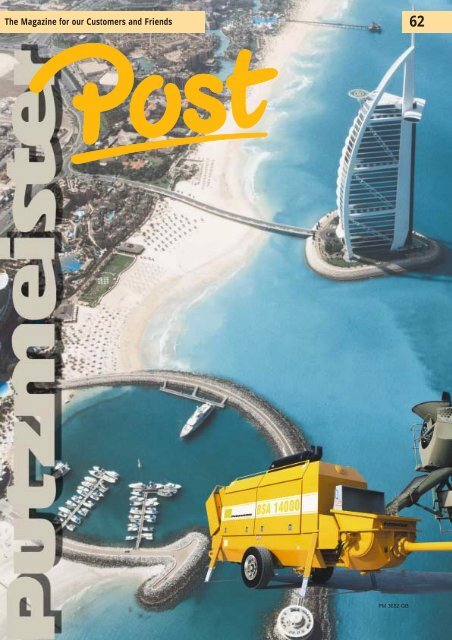
![Data sheet BSA 1005 D SV (TB 2206) [.pdf; 459.58 kb] - Putzmeister](https://img.yumpu.com/51174022/1/184x260/data-sheet-bsa-1005-d-sv-tb-2206-pdf-45958-kb-putzmeister.jpg?quality=85)
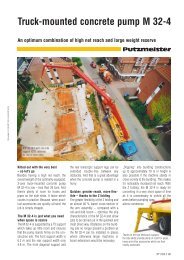
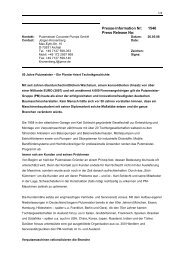
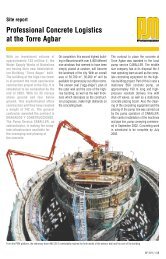
![Typenblatt CS 3095 [.pdf; 202.40 kb] - Putzmeister](https://img.yumpu.com/50530164/1/184x260/typenblatt-cs-3095-pdf-20240-kb-putzmeister.jpg?quality=85)
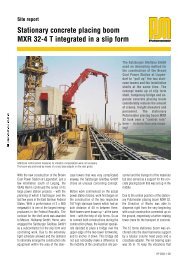
![M 47 Broşürü [.pdf; 527.92 kb] - Putzmeister](https://img.yumpu.com/49631771/1/190x141/m-47-brosuru-pdf-52792-kb-putzmeister.jpg?quality=85)
